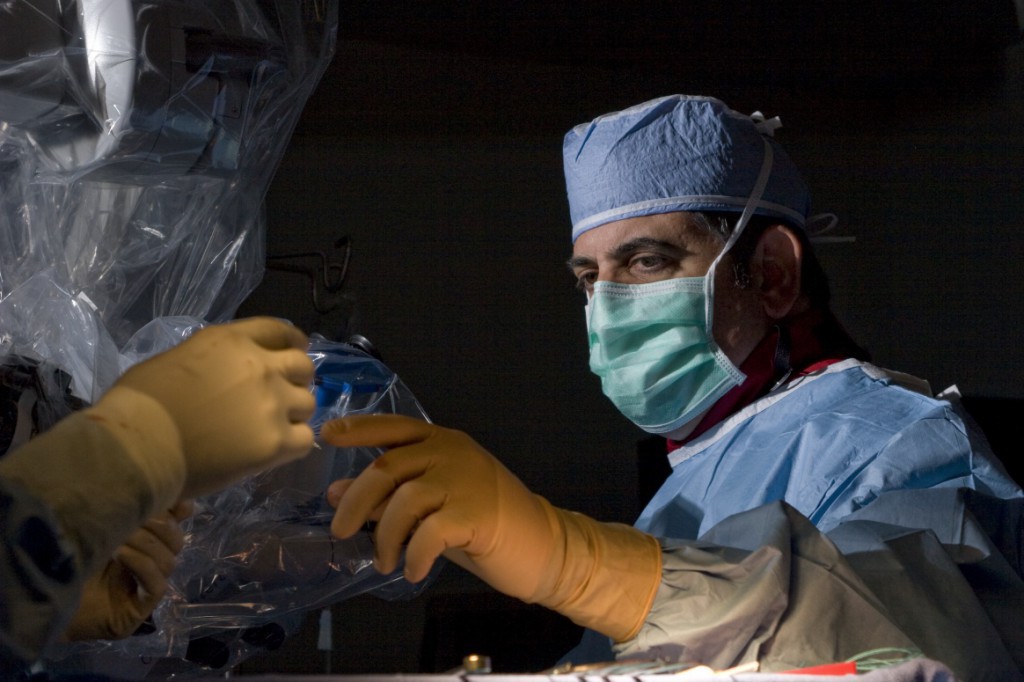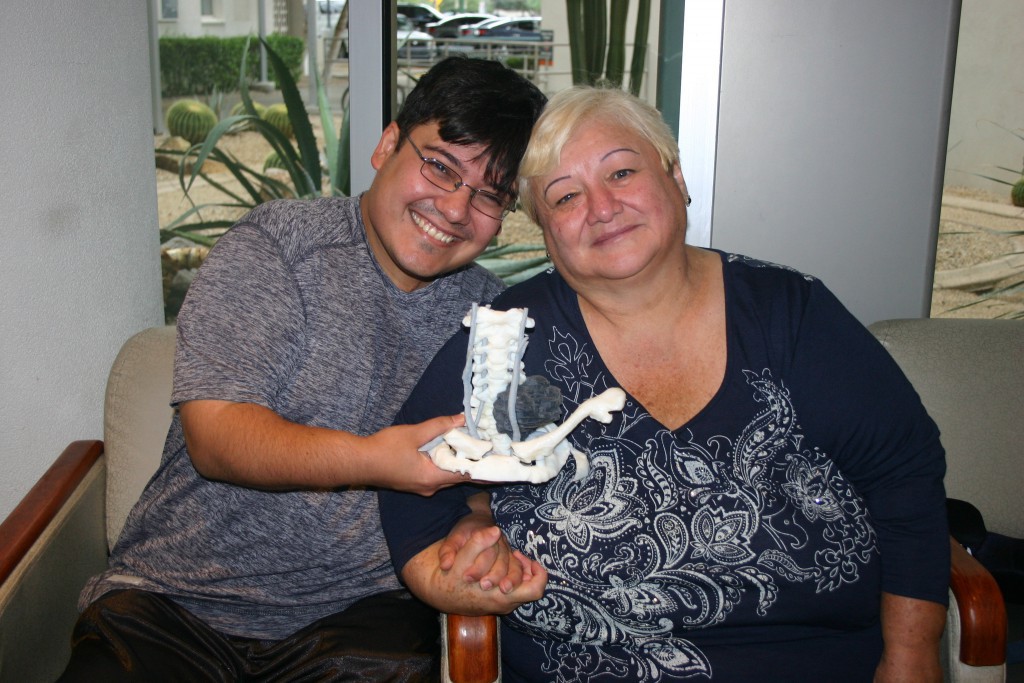It was a devastating blow. After a lifetime of battling a rare bone disease, 32-year-old Ollie Rodriguez was faced with the possibility of becoming paralyzed on his left side in order to save his life.
As an infant Ollie was diagnosed with multiple hereditary exotoses, a condition where tumors grow on the bones of the body. The bone tumors are called osteochondromas. Throughout his childhood he visited with his neurologist regularly to monitor the growth of the tumors for any changes that might affect his vital organs or mobility. At age 10, doctors discovered an osteochondroma growing in his neck and pushing on his carotid artery and cervical spine.
The danger of a tumor in this area was that there was the chance of the tumor blocking the blood flow completely to the artery and causing a major stroke. It might grow into the spine and cause paralysis or even death.
“It was devastating news to hear as a 10-year-old boy,” said Ollie. “Of course, all I could think about was not being able to play basketball.”
Thankfully, after an angiogram, doctors were relieved to learn that Ollie’s body had adjusted to the foreign object by expanding the flow of blood into the other artery, and the tumor was not growing in size at that time. This meant that they would continue to simply monitor his tumors. Ollie could go on to live a normal childhood.
Ollie did just that. He graduated high school and went on to earn a masters degree in Aerospace Engineering from Georgia Tech.
In February 2015, when Ollie went for his annual routine MRI to check in on his tumors, he found out that the tumor in his neck had started to grow.
“Initially I was shocked,” said Ollie. “Then I felt a little guilty. All I could think was… what could I have done to make this tumor start growing?!”
 The doctors explained that sometimes tumors like these remain dormant for many years before they start growing in size. And that was the case for Ollie.
The doctors explained that sometimes tumors like these remain dormant for many years before they start growing in size. And that was the case for Ollie.
But Ollie was determined to find answers. He was determined to figure out how to get could get this tumor removed, and so he began his relentless research.
“All of the doctors I saw were telling me that this was the most high-risk surgery there was,” said Ollie. “And of course because of the location of the tumor and the alarming rate at which it was growing, I needed to have it removed quickly.”
He sought to find the best neurologists and neurosurgeons in the world. He spoke to experts at Johns Hopkins, Mayo Clinic, Cleveland Clinic and even MD Anderson. Everybody told him the same thing. Operating to remove the tumor would leave Ollie’s body paralyzed completely on his left side.
“Once again I was in shock,” said Ollie. “Imagine someone telling you that after you wake up from an operation, you would no longer have any use of your arm— and possibly your leg too. No longer could I hike or climb or tackle other physical activities on my bucket list. I wouldn’t even be able to do my job anymore without a specialized keyboard.”
Ollie spent a few months digesting the idea of becoming paralyzed and decided to continue his research for any glimmer of hope. He felt there must be an alternative. That’s when he remembered Nicholas Theodore, MD, neurosurgeon at Barrow Brain and Spine in Phoenix, Ariz.
“My first job out of grad school was with Orbital Sciences Corporation in Arizona,” said Ollie. “It was there that I found Dr. Theodore, who I saw for my annual check-ups on my tumors.”
Dr. Theodore remembered Ollie and agreed to take a look at the MRI. He noted that the tumor had grown substantially—about 25 percent— and an operation was definitely a necessity.
“My initial thought was to attempt to remove the tumor in two separate operations,” said Theodore. “One surgery would be done from the front of the neck and the other from the back.”
Theodore explained that doing the operation in stages allowed a better chance at sparing the nerves. This approach might save Ollie from becoming paralyzed.
“It would also allow us to diagnose the tumor after the first operation and reassess our plan, as needed, for the second surgery,” said Theodore.
Ollie was thrilled. He immediately made plans with his employer in Baltimore for an extended medical leave and flew out with his mother for the operation.
Felipe Albuquerque, MD, teamed up with Dr. Theodore for this tricky and extremely high-risk operation.
It turned out to be a three-day operation beginning with an angiogram taken by Dr. Albuquerque to access the blood supply of the tumor. His goal was to identify where the normal blood vessels were and if there were any feeding vessels that could be embolized in order to decrease the tumor and its blood supply.
Once that first operation was done, the second operation began. This time Ollie would be lying on his back so they could open the front of the neck.
“We had to be very cautious because the carotid artery was wrapped around the tumor and the nerves were located directly in the center of the tumor,” said Dr. Theodore.
The team used a microsurgical technique to take out the tumor— carefully removing the tumor from around the nerves that controlled movement of the arm and leg.
 For the third and final operation, the team used a special computer program to perform a CT scan during the surgery. This essentially served as a GPS device for the spine—allowing them to very carefully remove the tumor that was invading the back of the spine and then to stabilize the neck with a few rods and screws.
For the third and final operation, the team used a special computer program to perform a CT scan during the surgery. This essentially served as a GPS device for the spine—allowing them to very carefully remove the tumor that was invading the back of the spine and then to stabilize the neck with a few rods and screws.
“After the 3rd surgery, the only thing I remember was lifting up my left arm, wiggling it around, and falling back asleep on the operating table with an amazing feeling of relief,” said Ollie.
The surgical team had successfully removed the tumor completely without affecting any aspect of Ollie’s mobility.
“I am a man of faith,” said Ollie. “I feel like my faith brought me to Dr. Theodore, Dr. Albuquerque and their team.”
Ollie continues to embrace every day— with full function of his left arm and leg. Every day is a new day and he emphasizes with a smile that he looks forward to getting back to work to use his fully functional keyboard.
As a Barrow patient, you can feel confident we’ll exhaust every avenue to arrive at a proper diagnosis and treatment plan customized specifically for you. Request an appointment online and our Patient Navigator will guide you through the next steps.
Request an Appointment